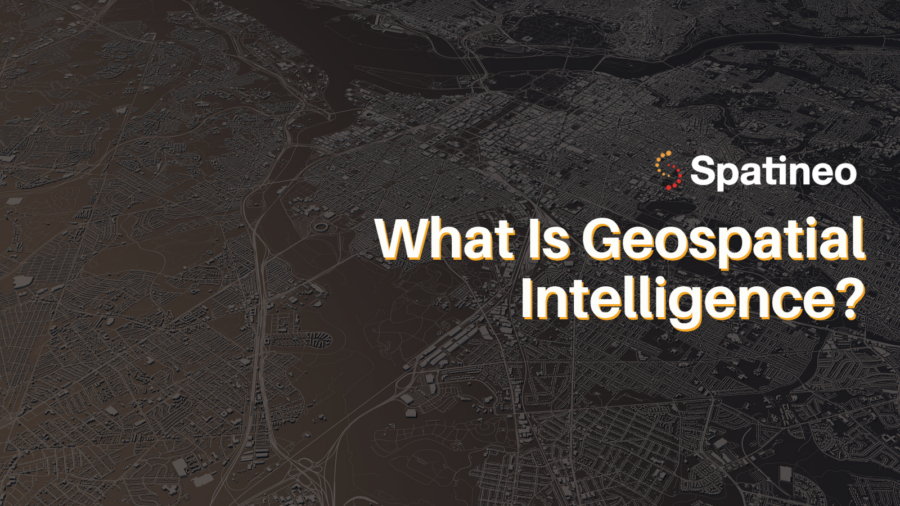
Over the last few decades, digital data has become the foundation upon which organizations, businesses, and governments make decisions. Today, the collection, assessment, and usability of relevant and timely data is the difference between success and failure.
Consequently, many companies and institutions now use geo-intelligence to understand the relationships between data and their customer base to improve decision-making and enhance customer experience.
Let’s explore what geospatial intelligence is and some of its real-life applications.
What is Geospatial Intelligence?
Geospatial Intelligence is a discipline that utilizes geospatial data and imagery to analyze, define, and visually display the earth’s geographically referenced activities and physical features. It combines fields like imagery intelligence, imagery analysis, charting, and mapping.
But why is geospatial intelligence important?
The governments, private sector, and civilians working in public health, transportation, and telecommunications use spatial data technologies such as QGIS to analyze spatial data to make forecasts and improve quality of life.
Geospatial intelligence carries contextual information and location that offers new opportunities to comprehend essential aspects of an organization. A geospatial intelligence analyst usually derives geospatial intelligence from spatial data sources and assesses imagery-based sources to answer intelligence questions.
The Four Essential Components of Geospatial Intelligence
1. The discipline of geospatial intelligence
The geospatial intelligence discipline involves collecting, planning, processing, disseminating, exploiting, and analyzing spatial data to gain intelligence, visually depicting it, and fusing it with other data through visualization and analysis.
Technological advancement has enabled companies to combine and use geospatial information in different ways to create interactive visual products. In other words, A geospatial intelligence analyst can make connections between various data faster than ever.
The discipline comprises more than processes, technology, and systems; it also encompasses skilled professionals who have propelled this discipline.
2. The data that comprise geospatial intelligence
Geospatial intelligence data is any data used to create geospatial information derived from various sources.
Companies can obtain geospatial data from web page visits, app downloads, data from vendors and partners, POS systems, and cross-department information using several methods, such as sensors and platforms.
3. The process used to develop geospatial intelligence products
Geospatial intelligence products range from specialized products that use four dimensions and incorporate information from multiple advanced sensors and standard derived products like imagery and maps.
The products are usually developed from a value-added process wherein the geospatial intelligence user and producer update a product or database with current data. geospatial intelligence services support the management, generation, and use of geospatial intelligence products and data.
Many companies also conduct intelligence analysis to ensure the developed product is comprehensive.
4. The products derived from geospatial intelligence
Companies find plenty of uses for geospatial intelligence in real life. Tuulituhohaukka project developed by Spatineo is an example of a product derived from geospatial intelligence.
In this project, Spatineo partnered with FMI (Finish Meteorological Institute) to create a tool to analyze the algorithm that the meteorological institute used to assess areas at risk of being hit by strong winds.
Spatineo developed the web app displaying all the available data variations from scratch. We also incorporated STAC (SpatioTemporal Asset Catalog), which allows the efficient utilization of satellite images in the app.
Geospatial Intelligence Use Cases and Applications
1. Precision location data
From weather, crime, retail purchases, banking transactions, and social media information, location plays an important role. Precise location data is valuable and being produced at a staggering rate.
Research conducted by McKinsey indicated that by 2025, data derived from IoT (Internet of Things) connected devices and sensors might have an economic impact of over $11 trillion annually.
Location intelligence helps businesses make smarter decisions about network optimization, resource allocation, routing, risk management, targeted marketing, and site selection. That’s how Spatineo Impact allows companies to analyze spatial data to produce correct, actionable insights.
2. Virtual and augmented reality
Geospatial intelligence services can also create realistic simulations of specific locations entailing the structures, elevation model, and terrain. Information layers such as traffic, surveillance data, sensor readings, and disaster damages provide an opportunity to visualize valuable data to aid decision-makers in having a view of a location’s predicted, historical, and current conditions.
The digital twin concept is a classic example of geo-intelligence in the virtual reality sphere. A digital twin is a virtual depiction of real-world processes that serve identical digital counterparts for its practicality, e.g., maintenance, monitoring, testing, and simulation. The studied item is fitted with sensors related to essential functionality areas. The sensors then produce data about the item’s performance, e.g., energy output.
3. Data analytics
Geospatial intelligence data analytics rely on specific identifiers like zip codes and geographic coordinates to create data visualizations and geographical models for accurate trend forecasts. A geospatial intelligence imagery analyst assesses geo-referenced images to evaluate possible risks.
Geospatial data analytics adds location and timing to data; hence no insights are lost. Spatineo impact allows organizations to conduct data analysis to utilize data flows efficiently.
4. Remotely sensed information
Remote sensing refers to monitoring and detecting an area’s physical characteristics by measuring emitted and reflected radiation at a distance. The sources of remotely sensed information are usually aircraft and satellites with cameras that take images of the earth’s surface.
Remotely sensed data is used in various industries for various purposes. For example, corporations monitor clouds to forecast the weather and monitor urban growth. Sentinel 2, which produces satellite imagery to monitor crop growth and forests, is another excellent example.
Geospatial Intelligence Real-Life Examples
1. Building and land development
Information technology development has substantially changed the approach to managing natural resources, spatial planning, and land use.
Geospatial intelligence is used in the land development industry to model the spatial distribution of the atmosphere, hydrological network, and mobile sources in soil. Based on this analysis, the system chooses the best land-use solution with minimum environmental impact.
In Finland, it’s estimated that the realized benefits of using geospatial intelligence in the building industry are EUR 780 million annually. Spatineo has partnered with the Finnish Environmental Institute to develop the Mammuti project, which uses spatial data for enhanced monitoring, planning, and reporting of land use to mitigate climate change.
In the building industry, geospatial intelligence services are used for monitoring, managing, and planning building activities. Analytic algorithms help users perform analysis and customize their user experience to add charts and histograms when the need arises.
Poland’s architecture, Engineering, and Construction (AEC) companies use the FME tool as they work with spatial data in different formats and from various sources. FME integrates the data across systems and streamlines workflows so that teams can operate, plan, build, and design more accurately and efficiently.
2. Public management
Governments use geo-intelligence to improve public management in various ways.
For instance, it’s being used in Europe to replace old gas pipes — the government is using geospatial intelligence to identify old pipelines near high-risk sites like hospitals and schools. This allows the government to progressively replace the old pipes to maintain the system while keeping citizens safe.
Companies such as CloudPermit are partnering with local governments in Europe to digitize planning processes and create property details. This makes it easier to locate property owners and contact details for public notice.
3. Utility companies
Utility firms use geospatial intelligence differently; hydro firms and railway lines utilize geospatial intelligence with analytics to establish the steps for resolving some issues.
For instance, if drones, sensors, or cameras detect branches getting close to railway lines or hydro wires, a geospatial intelligence system can help determine the appropriate actions, such as calling a maintenance team and selecting the correct professional to handle the repairs.
Geospatial intelligence systems also optimize a drone’s schedule to tour all areas that require inspection, which saves on costs. Geospatial intelligence sensors are susceptible; thus, they can detect if an area of the lake that leads to a hydroelectric dam is wasting away or if the water levels are reducing.
4. Business modernization
Businesses within numerous industries are using spatial data to get a competitive edge.
For example, optical fiber installations around the world are booming right now. While digging up new underground lines, the fiber companies could benefit quite a bit from analyzing where current lines are in the ground, what kind of soil they are digging into, and where they should focus first on their operations.
Conclusion
As you can see, geospatial intelligence significantly impacts how governments and businesses within numerous industries operate and improve our quality of life.
Contact us to learn how to use data flows to foster growth and create a foundation for new business opportunities. Spatineo is a leading expert in helping companies build efficient data flows based on geospatial intelligence so that it can become a valuable asset for your success!

Want to stay updated?
-
New employee Mikko EhnqvistNew Employee Mikko Ehnqvist Hi! My name is Mikko, and I joined Spatineo in the spring of 2024. Transitioning to this innovative Finnish software company from a 20-year career in sales—most recently in the music industry and international business—has been an adventure. My experience in global sales, particularly in the […]
-
How Modern Analytics Tools Improve Open Data ServicesModern analytics tools can illuminate how geospatial APIs are used. They can reveal which services are most popular, what data is acquired through the API, the geographical areas of interest for those requests, and the origin of these requests. Additionally, they can monitor service availability, track downtimes, and identify performance […]
-
Spatineo Building NATO Standards Compliant Metadata Capability for the Finnish Defence ForcesEnsuring good and efficient geospatial data management is crucial for successful training, planning and operations in the defence sector. The ability of NATO members to exchange geo-information in a secure and standards compliant way is key to successful and timely collaboration and building cross-national operational capability. Spatineo continued successful collaboration […]
-
New Age of Data Security: AI’s Role in Enhancing FTIA’s Digital Twins’ CybersecuritySpatineo proudly facilitated the Finnish Transport Infrastructure Agency’s (FTIA) workshop, focusing on the future of digital twins and information security. The workshop aimed to innovate AI-based solutions to enhance the cybersecurity of digital twins. Leveraging Spatineo’s expertise in digital infrastructure and data flows, we explored FTIA’s innovative plans for digital […]
-
Spatineo and Elenia Join Forces to Create a Groundbreaking Digital Service: Capacity MapSpatineo developed an interactive electrical grid Capacity Map to simplify communication between Elenia, their project developers and customers.
-
Exciting News: Spatineo Inc. Awarded NRCan Tender for Geospatial Web Harvester Development and OperationsWe are thrilled to announce that Spatineo Inc. has been awarded both Stream 1 and Stream 2 of the tender by Natural Resources Canada (NRCan) for developing and operating the “Geospatial Web Harvester Development and Operations” project. The contract value is CAD 213 570.00. We are happy to continue working […]






